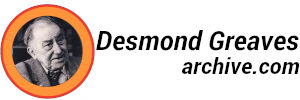Saints Brendan, Columcille and Columbanus
[Review by Desmond Greaves, under the pseudonym “Ciaran Desmond”, of the book by Brendan Lehane, The Quest of the Three Abbots: The Golden Age of Celtic Christianity, John Murray, 1968, 42/- in the August 1968 issue of the “Irish Democrat”]
– – –
The three Abbots of the title are here considered as archetypes of three kinds of activity resulting from the impact of Christianity on Ireland’s strange old civilisation.
Brendan the Voyager stands for the thrusting imagination, the curiosity about the universe, the total trust in God. Columcille – here always called Columba, British-style – represents the influence on Christian Britain of a spirit largely formed in pagan Ireland.
The career of Columbanus typifies the leavening of the Christianity of the Roman Empire in decline by the ideas of a people the Empire had not touched.
Some of Mr Lehane’s assumptions about early Irish history are open to question, to say the least. He accepts as fact a heroic age in Ireland lasting a thousand years with his meridian at the birth of Christ, disregarding the opinions of O’Rahilly, Binchy, Dillon and, very recently. R.P.C. Hanson and J. V. Kelleher, all of whom reject the evidence of the Irish annals on this matter; they explain the annalistic accounts as euhemerisation, or myth historicised.
In the same way the idea of a “High King of Ireland” reigning at Tara from about the second century A.D, uncritically accepted here on the authority of writers like J.B. Bury, has been regarded by most recent scholars as the invention of early-mediaeval historians wishing to glorify the dominant O’Neill dynasty. In one place Mr Lehane seems to suggest that part of St Patrick’s “Confession” is a refutation of Pelagianism, which Patrick never mentions.
In another he attributes to the Irish a delight in classification on no other evidence than that their earliest literature fits under such headings as Wooings, Battles, Feasts, Cattle- raids, Voyages, Massacres. These groupings were, of course, arranged by literate redactors of a much later age, and they would be equally appropriate for the earliest Greek literature. with tales of goatherds and shepherds replacing cattle-raids. Elsewhere he seems to think it historically noteworthy that our ancestors had such a high opinion of themselves in spite of not having been conquered by Rome.
It is better to regard the book as an essay in biography than as a contribution to the many controversial issues it touches upon. Thus considered it makes good reading. The author shows that, while the Brendan legend may derive from multiple sources, the journeys were real. Irish settlements existed certainly in the Faroes, Iceland, Greenland and possibly in America before the eighth century. St.Columbanus has been canvassed as the patron of a united Europe. Mr Lehane shows that he has as good a claim to be considered Europe’s first socialist reformer for his stand against both tyranny and poverty and for his pioneer work in education and agriculture.
The book succeeds in presenting all three characters as men of their time and nation.
They were indeed men to take the breath away. If Brendan’s voyages strain credibility, when the greatest hazard was from tempest and iceberg, what are we to think of the unmitred Columcille carrying his message to the court of King Bude. surrounded by scheming druids and apostate Picts? Or of the septuagenarian Columbanus, already expelled from France for his forthright assault on kingly immorality, denouncing in thundering terms the Arianism of the nobility of Lombardy?
It may be fanciful to suppose, as Mr Lehane does, that the Irish influence on English Christianity, persisting after the defeat of Colman by the Roman party at the Synod of Whitby, was a predisposing factor in the rupture between Roman and Canterbury nine centuries later.
Yet he makes it clear that certain Irish traits – devotion to art and to pagan literature, eager acceptance of privation, and readiness to carry the Gospel to the ends of the earth – passed into the English church as they did into that of Merovingian Europe, to imprint a faint but unmistakeable Irish character on the culture of the Middle Ages. The book’s greatest merit is that it shows this process at work in the lives of its three exemplars. They were giants in those days.
